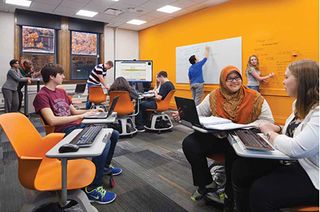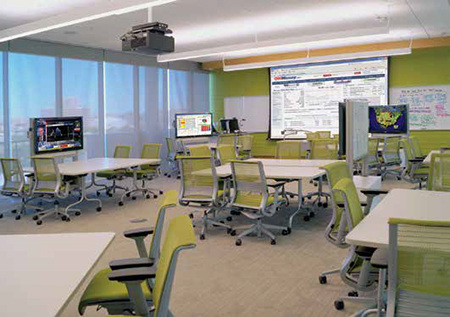Missouri Kansas City Bloch School of Management’s new Executive Hall There’s possibly no greater pressure and spotlight on an overall institution to perform, as there is on higher education right now. A recent Pew Research Center study, “U.S. Labor Force by Generation, 1999-2015” states that as of the first quarter of 2015, Millennials (adults age 18 to 34 in 2015) have surpassed Generation X to become the largest share of the American workforce. In addition, the report said, “a significant chunk of the Millennial population are 18- to 24-year-olds,” in other words, college age. Are you ready—now?
Competition is fierce when it comes to recruiting each student, and earning their four-year commitment. Standing out as an institution that is already embracing a pedagogy that incorporates technology to help ensure that student’s chance of securing the best job when entering the even more fiercely competitive workforce is critical.
We reached out to industry experts and your peers to help provide some perspectives including ones that differ, practical advice, some opinions, and let you know that no matter where your college or university is on the technology scale, you’re not alone.
1. PRIORITIZE—ON STRATEGIES FOR PLANNING AV THAT IS ESSENTIAL NOW, BUT WITH FLEXIBILITY TO GROW/UPGRADE?
Chris Imming, CTS-I, CTS-D, director of media services, Classroom Design at Gordon College: We build systems to maintain a minimum technology offering and then seek to have expansion options already built into switchers with spare inputs and control system programming.
Gina Sansivero, director of educational sales at FSR, Inc., a U.S. manufacturer, which offers connectivity, infrastructure, AV and collaborative technology products worldwide: Considering the rate at which technology changes and then taking into account the type of project that is being proposed (new construction has a longer “leadtime” than individual classroom updates) available classroom technologies may have changed or become unavailable between the planning phase and actual installation. While “future-proof” is seemingly impossible, “future-resistant” installations are necessary. Planning for easily replaceable connectivity, using standard size plates and infrastructure equipment is a good start.
Rooms are more frequently moving from standard lecture to transitional spaces with modular furniture and multiple “front of rooms.” Making sure the connectivity and power is well placed for a variety of room layouts will offer future flexibility.
Keeping files of complete documentation for all equipment will ensure that maintenance and future replacement technologies will be easily defined (in new construction, BIM can aid in keeping documentation, warranty, and replacement part information in one digital “binder.”).
Craig Park FSMPS, ASSOC. AIA, and principal consultant at technology consulting firm, The Sextant Group:
The challenge with design standardization is that it implies a fixed solution at a moment in time. Today, technology is changing at such a rapid rate that it is more important to develop bespoke solutions based on best-practices that meet a given curriculum’s specific needs for information exchange than to implement standards that only partially meet educational goals. Technology needed for general studies will rarely apply to STEM or specialized programs. It is important that early planning discussion focus on learning goals ahead of technology and space design.
For the University of Missouri Kansas City Bloch School of Management’s new Executive Hall, the focus on collaboration lead to an evaluation of a number of solutions that align with different types of class settings from team-based “active learning” to more traditional U-shaped Harvard-style case method classrooms, to “Venture Accelerator” huddle spaces and a larger lecture hall. In all cases, a technology platform for digital routing and switching (Crestron DM), group collaboration platforms (TideBreak ClassSpot PBL), and interactive screens were “standardized”, though the implementation of each changed depending on the room and/or application type.
2. OPTIMIZE FOR AV/IT CONVERGENCE—WHAT ARE YOU DOING ON YOUR CAMPUS?
Jesse Anderson, CTS-D, audio-visual services director for Information Technology Services at College of the Holy Cross, and chair of the InfoComm Technology Managers Council:
The AV department got merged into our Information Technology Services department a few years ago. I now sit at the table with the heads of the network, security and user support groups (among others), so there is forum for discussing AV’s particular needs and how to fit them into a wider campus strategy.
Chris Imming, Gordon College: Since we are a small school our AV and IT departments have always been close and work well together so it’s not new for us.
Jahn Westbrook, technical manager for Classroom Media Services at New York University: AV and IT are separate departments at NYU, collaborating on unified projects often. There is a clear division of focus and open communication, which serves our needs well. We have specific points of contact in each department, which streamlines the communication. This removes duplicate questions from multiple people. Any work that needs to be done or followed up on, goes through those individuals and has sped up the resolution process.
We are still learning the nuances of each department, but what we have come to a clear understanding is that neither department needs to know ALL of both departments.

3 TEST IT/VET IT—RELIABILITY COMES FIRST
Jesse Anderson, College of the Holy Cross: We make extensive use of our AV Network Management Suite to help determine trends. Our system tracks utilization by source in each room, so we can look for long-term patterns. IT is used to this — network managers have used bandwidth and other data for years when making decisions, and there is no excuse for AV not to do the same thing. Chris Imming, Gordon College: When possible we arrange for demo units from our technology partners. When we are evaluating new comprehensive room designs we will often build out one room and have faculty, students, and staff provide feedback before we launch it across campus.
David Glenn RCDD, CTS-D, LEED AP BD+C, systems designer at The Sextant Group: Product demonstrations and hands-on testing is important. If considering deploying a new product across a campus or enterprise environment, technology managers should install a completely functional system to discover any potential issues during the integration into existing systems or potential shortcomings with the product prior to deploying.
4. ACCESSIBILITY—ARE ALL OF YOUR USER’S NEEDS BEING MET?
David Glenn, The Sextant Group: When designing classroom AV systems, it is important to be conscious of ADA compliance for both faculty and students. Having a discussion with the campus ADA-compliance officer during early stages of a design helps to ensure that any campus accessibility standards in addition to ADA standards are followed.
Accessibility influences a variety of aspects of the AV systems in a classroom including the design of the teaching or presentation location such as a lectern; reach heights, ranges and limits to control panels and wall plates; assistive listening requirements; closed captioned media; visual sight lines to the accessible seating areas; and the integration of convenience power and technology with ADA accessible tables.
5. PLANNING FOR CHANGE—HOW DO YOU PLAN FOR INEVITABLE CHANGES IN TEACHING/LEARNING STYLES/PEDAGOGY?
Chris Imming, Gordon College: Hybrid course design blending live lecture capture and studio pre-produced content delivered in an asynchronous learning environment has provided new opportunities for our students.
The evolution of the hybrid course design may result in further development of fewer specialized technology classrooms while also reducing the propagation of a standard of technology infrastructure in all learning environments.
Gina Sansivero, FSR Inc: Teaching styles/pedagogy and student interaction have to be discussed and changed during room planning, not as a result of room planning or after the plan has been implemented and the technology and furniture installed. The re-evaluation of both existing and new spaces should start prior to the room design by understanding the teaching style most likely to be used in that room. What are the goals of the room, what are the goals of the department, what are the goals of the school? Then bring the whole team together including designers, integrators, technology managers, instructors, instructional designers or trainers, administrator and, if possible, student advisors. Optimal usage of classroom technologies and increased successful student outcomes are reliant on well-designed spaces, intuitive equipment, minimal training, and a complete overhaul of traditional pedagogy.
6. FACULTY TRAINING—HOW TO ENSURE TECHNOLOGY IS USED TO ITS POTENTIAL?
Jesse Anderson, College of the Holy Cross: We have a couple of approaches to this. We’re never sure when they work, but we always know when they fail!
Whenever possible, we standardize equipment in academic spaces. To the user, the control system is the system. They don’t really care what model display we’re using, they just want to know how to turn it on and show their media. For years, “simple” has been the goal in control system design. We are trying to move beyond that to “familiar,” making sure that users already know how to use the room based on other rooms they have used.
The simplest thing we’ve ever done is to place a sign in each classroom with brief instructions on operating the equipment. While uniform in design, each sign is unique to the room’s equipment and prominently features the Helpdesk and AV Group’s extensions at the top.
Nancy Sturm, principal consultant at The Sextant Group: With the abundance of online resources and the shift toward collaborative student/faculty relationships made easily accessible wirelessly anywhere on campus is driving educators to revisit their roles. Many campuses are developing “train the trainer” programs that put the faculty in the student’s role using simulations to help them experience active, problem-based, experiential learning in an authentic learning setting. Insights drawn from the simulation experience enables faculty to leverage online resources and structure rubrics to better meet their learning goals.
Jahn Westbrook, New York University: We have instituted a pre-semester training schedule for all faculty to see our new classrooms, to orient faculty to specific classrooms they’ll teach in, or to familiarize themselves to a specific technology. We also provide daily demonstrations prior to class instruction for any faculty member. Having instructions in each classroom also helps to abate questions on equipment functionality.
We always focus on new installations or new technology to demonstrate to faculty. We would also use our previous semester’s technical call log and focus next semester training on any area where there was a high volume of calls for assistance. Having a sense of trends to offer training supporting that ideal. For example, when we saw Mac laptops were being used more frequently, we held a training session dedicated to connecting the adaptors to the provided support cables, encouraging faculty to BYOD in order for them to see exactly what was needed specifically for their laptop.
7. SECURE AND LEGAL—CONTENT STREAMING POSES CHALLENGES
Chris Imming, Gordon College: HDCP continues to be a challenge in the higher education market when it comes to lecture capture. For the most part it is not an issue as our faculty tend not to be using a lot of theatrical movie or iTunes releases within their courses. For many classrooms, we avoid lecture capture if the course is going to be reliant on HDCP content but our lecture capture recordings are also limited in distribution by LDAP authentication so only students enrolled in those courses have access.
David Glenn, The Sextant Group: Most manufacturers have integrated HDCP management into their products to allow protected content to be presented. However, there are some collaboration software packages and wireless presentation systems that do not support HDCP. Therefore it is important to understand the type of content that will be presented and if HDCP management will be required before selecting a solution.
Images courtesy of The Sextant Group and Bostwick Design Partnership, Inc. Copyright: Scott Pease / Pease Photography, 2013.
More Info:
THE AMERICAN INSTITUTE OF ARCHITECTS
www.aia.org
EDUCAUSE
www.educause.edu
INFOCOMM INTERNATIONAL
www.infocomm.org
NATIONAL CENTER FOR ACADEMIC TRANSFORMATION (NCAT)
www.thencat.org
THE NEW MEDIA CONSORTIUM
www.nmc.org
SOCIETY FOR COLLEGE AND UNIVERSITY PLANNING (SCUP)
www.scup.org
RESOURCES
AV/IT INFRASTRUCTURE GUIDELINES FOR HIGHER EDUCATION
http://www.infocomm.org/cps/rde/xchg/infocomm/hs.xsl/40836.htm
ECAR STUDY OF UNDERGRADUATE STUDENTS AND INFORMATION TECHNOLOGY, 2014
https://net.educause.edu/ir/library/pdf/ss14/ERS1406.pdf
NMC HORIZON REPORT > 2015 HIGHER EDUCATION EDITION
http://www.nmc.org/publication/nmc-horizonreport- 2015-higher-education-edition/











